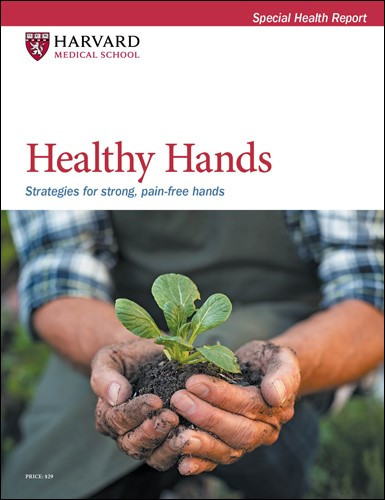Winter activity workarounds for hands that hurt
Try these strategies to accomplish winter tasks, despite hand arthritis.
- Reviewed by Anthony L. Komaroff, MD, Editor in Chief, Harvard Health Letter; Editorial Advisory Board Member, Harvard Health Publishing

The pain and stiffness of hand arthritis make it hard to do anything that requires nimble fingers or a strong grip. And for some people, cold, damp winter weather seems to worsen arthritis symptoms. "We don't know exactly why that happens. All we have are theories, such as bones expanding from changes in barometric pressure, changes in circulation, 'thickened' joint fluid, and the effects of less exercise due to cold weather," says Dr. Robert Shmerling, a rheumatologist and senior faculty editor at Harvard Health Publishing.
So how can you get through a busy winter filled with activities that demand a lot from your hands, such as preparing holiday feasts or shoveling snow? The key is to plan, pace yourself, use the right tools, and enlist help if you need it. Here's how to apply that to some common winter activities.
Holiday cooking
Cooking is intense work for your hands, whether you're whisking a savory sauce, kneading or rolling out dough, chopping vegetables, or lifting heavy pots and pans.
Plan. Think about the steps of each recipe and ways to reduce the amount of grasping or lifting that might be required. "For example, if you need to fill a large stock pot with water, place the pot on the stove first and then add water using a pitcher, so you won't have to lift a heavy pot," says Kim Stuckart, an occupational therapist at Spaulding Rehabilitation Network.
Pace yourself. Spread out cooking activities as much as possible so you don't overwork your hands. That could mean making one special dish per day (and freezing it) prior to a holiday meal, or baking holiday cookies well in advance and freezing them. And take breaks while you're cooking, to let your hands rest.
Use tools. "Adaptive kitchen tools are plentiful, such as tools with large handles that are easier to grip and put less stress on your hands, or bowls with suction cups on them, so you don't have to grip them to hold them steady," Stuckart says. "And when possible, use kitchen appliances — such as a food processor or an electric can opener — to do prep work for you."
Enlist help. Consider asking family members to help with the cooking, or have part or all of the meal catered if it's in the budget. It doesn't have to come from a fancy restaurant. For example, many grocery stores prepare and sell cooked turkeys and holiday dinners.
Shoveling snow
Shoveling heavy, wet snow is taxing on your heart (it's strenuous exercise) and painful for arthritic hands. "It hurts to grasp a shovel, and it can lead to muscle strain and increased joint inflammation if you hold your hands in one position for long periods," Stuckart says.
Plan. Before you head outside, get your body ready for hard work with a warm-up (march in place and move your arms for a few minutes). "This gets blood flowing to all of your muscles and tissues, including your hands, which will help keep them warm and flexible," Stuckart says. Before going out, suit up properly in cold weather gear, including a pair of compression gloves ($10 and up) beneath mittens. The gloves will promote warmth and blood flow.
Pace yourself. Go slowly and steadily, take breaks, and stay hydrated (ideally with hot drinks). Even though it's cold outside, you'll lose fluids during exertion.
Use tools. If it's in the budget, get a snow blower or an electric snow shovel, which you push like a lawn mower. They are pricey (in the hundreds of dollars) but help ease the work of shoveling.
Enlist help. If possible, hire a company to remove the snow for you. It's expensive and may require a long-term contract. If that's not in the budget, talk to family members or a neighbor (or a neighbor's teenage kids) about helping with snow removal. Make the arrangements now, before you wake up to a blanket of new-fallen snow.
Wrapping presents
One of the joys of the winter holidays is giving gifts to friends and family. But gift wrapping requires hand strength to use scissors, and agility in fingers and thumbs to fold paper, tape it, and tie ribbons. The repetitive movements can quickly become painful.
Plan. Buy presents as far in advance as possible, so you'll have plenty of time to get them ready.
Pace yourself. Don't overdo it. Wrap just one or two presents per day.
Use tools. Stuckart recommends using a large (accessible) tape dispenser (about $5) and adaptive scissors (about $15) that you operate by squeezing a large loop rather than opening and closing two handles. Or simply use gift bags.
Enlist help. When you're shopping, take advantage of gift-wrapping services (which are sometimes included in the price of the gift). Or ask a friend to help you wrap presents.
Using walking or ski poles
Nordic walking and cross-country skiing are popular cold-weather activities, and both involve the use of poles you grasp to pull or propel yourself forward. When you have hand arthritis, however, holding onto the poles for extended periods can be challenging and painful.
Plan. Make sure you're holding the poles correctly. They have a glove-like strap attached to the grip (handle). The straps need to be snug; if they're loose, your hands will work harder. If you're not sure about your technique, watch a free video on YouTube. Warm up before walking or skiing to get blood flowing to your muscles and hands.
Pace yourself. Take rest breaks and drink some water (or hot tea).
Use tools. "Look for poles with large, thick grips, which are easier to hold than small ones," Stuckart says. "And wear a pair of heated, rechargeable mittens. Keeping your fingers together will keep them warmer than they'd be in gloves. The warmth helps joints stay loose."
Enlist help. An occupational therapist can help you adapt existing poles so they're easier to hold with arthritic hands. "We have materials we can add to the make the grip larger," Stuckart says. "We can also evaluate your hand strength and prescribe a series of hand exercises to improve strength and flexibility."
Image: © Hill Street Studios/Getty Images
About the Author

Heidi Godman, Executive Editor, Harvard Health Letter
About the Reviewer

Anthony L. Komaroff, MD, Editor in Chief, Harvard Health Letter; Editorial Advisory Board Member, Harvard Health Publishing
Disclaimer:
As a service to our readers, Harvard Health Publishing provides access to our library of archived content. Please note the date of last review or update on all articles.
No content on this site, regardless of date, should ever be used as a substitute for direct medical advice from your doctor or other qualified clinician.
















